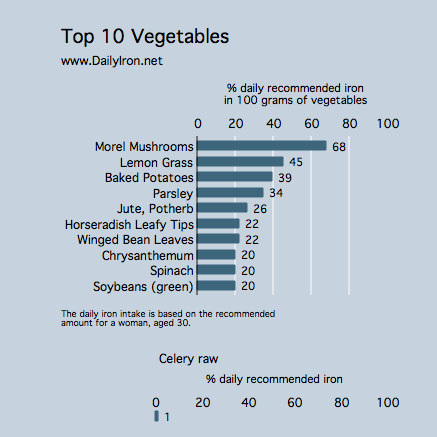Celery contains .20 milligrams of iron per 100 grams. Grams is a measure of weight. To put 100 grams in perspective, consider alternative measures for this food:
- 1 cup equals 101 grams.
- 1 NLEA serving equals 110 grams.
In the category of vegetables, we included whole vegetable products in the Top 10 list. We excluded dried/dehydrated products from the Top 10. You will find some dehydrated vegetables high in iron pebut they tend to be far more volume than anyone would consume. Furthermore, foods may be fortified with iron but are not included in this Top 10 list. The food tested for the particular graph below can be described more specifically as:
Celery, raw
Read more about iron in vegetables or visit our iron-rich foods list.

Vegetables generally are not a strong source of iron. Those vegetables that do contain iron also are more likely to be loaded with substances that inhibit iron — you may not absorb a great deal of the iron from the vegetable itself.
Nonetheless, even a vegetable with little iron can play a key part in your iron metabolism. Vegetables are often full of vitamin C, which can actually help you utilize the iron in non-meat food items; celery is a poor source of vitamin C.
Despite this, as an example you may wish to include tomatoes and green peppers with a whole grain salad or with legumes to improve your metabolism of the iron in your whole meal. A raw strawberry salad with your dinner would also raise your iron metabolism because of the fruit’s vitamin content. A glass of fruit juice is also a good plan.